This article introduces the paper "Die-Casting Feature Recognition for Automated Parting Direction and Parting Line Determination" published in the Journal of Computing and Information Science in Engineering in September 2007.
1. Overview:
- Title: Die-Casting Feature Recognition for Automated Parting Direction and Parting Line Determination
- Authors: Jatinder Madan, P.V.M. Rao, T.K. Kundra
- Publication Year: September 2007
- Publishing Journal/Academic Society: Journal of Computing and Information Science in Engineering
- Keywords: die casting, feature recognition, withdrawal direction, parting direction, parting line, design for manufacture
2. Research Background:
- Social/Academic Context of the Research Topic: Die casting is highlighted as a significant near net-shape manufacturing process. Similar to other processes in this category, die casting primarily utilizes two mold halves: the core and cavity (as illustrated in Fig. 1). The paper emphasizes that as the complexity of part designs increases, particularly during the product design phase, mold design and the overall manufacturability of the part become considerably more challenging. A key issue identified is that part designers often lack comprehensive knowledge of die-casting process intricacies, especially concerning parting direction and parting line determination. The current industrial practice is characterized by iterative cycles between part designers and manufacturing experts to ensure design manufacturability.
- Limitations of Existing Research: The paper points out that while researchers have proposed guidelines for parting direction and line selection, the lack of automation necessitates extensive data processing related to part geometry and shape. This manual implementation is time-consuming and requires significant effort from die-casting experts. Previous feature recognition research has predominantly focused on machining and sheet metal forming, domains with feature definitions distinct from die casting. Existing methods for die-casting feature recognition and parting direction determination are limited in several aspects:
- They often require substantial manual input and computational effort.
- Some methods are limited to specific types of surfaces (e.g., planar surfaces, polyhedral parts).
- Approaches based on local visibility may not accurately reflect industrial practices.
- Existing feature recognition techniques may struggle with complex, nested, and interacting features.
- Some methods rely on predefined feature libraries, limiting their adaptability to novel designs.
- Necessity of the Research: The research underscores the necessity for automated manufacturability analysis as a crucial tool to enhance design process efficiency and enable design-manufacturing integration. Furthermore, increased automation in process planning is essential for achieving higher efficiency and productivity in manufacturing. Automated determination of die-casting features, parting direction, parting line, side cores, and cavity numbers are vital inputs for process planning, directly impacting production time, part costs, and overall profitability. The paper specifically notes the limited attention given to process planning automation, particularly in automated die-casting feature recognition and automated selection of parting direction and parting line. Therefore, an automated approach for determining parting direction and parting line is crucial for die-casting design-manufacturing integration and automated Design for Manufacture (DFM) analysis. The proposed system aims to address these needs by directly utilizing product data from STEP files and identifying die-casting features for automated parting direction and parting line determination.
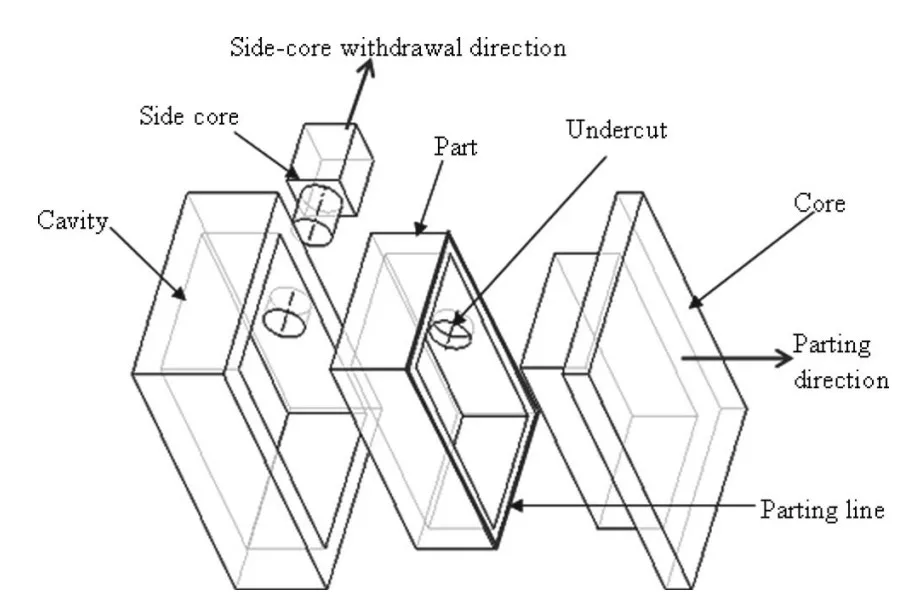
3. Research Purpose and Research Questions:
- Research Purpose: The primary research purpose is to develop a comprehensive automated system for:
- Die-Casting Feature Recognition: To automatically identify and classify die-casting features (protrusions and depressions) from part CAD models represented in STEP files.
- Automated Parting Direction Determination: To automatically determine the optimal parting direction for die-cast parts based on recognized features and process constraints.
- Automated Parting Line Determination: To automatically determine the parting line based on the selected parting direction and considering process constraints and priorities.
- Key Research Questions: The research seeks to answer the following key questions:
- How can die-casting features, including complex, nested, and interacting features, be automatically recognized from STEP file data without relying on predefined feature libraries?
- How can global visibility be effectively utilized in an automated system to determine withdrawal directions for die-casting features, aligning with industrial practices?
- How can process constraints and priorities be integrated into an automated system to determine the parting line based on the selected parting direction?
- Can an automated system be developed that overcomes the limitations of previous approaches in terms of comprehensiveness, accuracy, and applicability to complex industrial die-cast parts?
- Research Hypotheses: The central research hypothesis is that a newly developed automated system, leveraging STEP file input, geometric reasoning, global visibility analysis, and process constraint considerations, can effectively and comprehensively automate the determination of parting direction and parting line for die-cast parts. This system is hypothesized to be more comprehensive and overcome the limitations of existing automated approaches, providing results consistent with expert decisions in the die-casting industry.
4. Research Methodology:
- Research Design: The research employs a development and validation research design. It focuses on developing a novel automated system for die-casting feature recognition and parting direction/line determination. The system's performance and results are then validated against expert knowledge and industrial practices.
- Data Collection Method: The system utilizes STEP files (specifically AP 203/214) of part CAD models as the primary input data source. STEP files, being a neutral standard, ensure wider applicability across different CAD platforms. The system extracts geometric data directly from these STEP files, including face-edge and edge-vertex relationships.
- Analysis Method: The core of the methodology is based on geometric reasoning and a rule-based system.
- Feature Recognition: Geometric reasoning is applied to identify die-casting features, which are defined as protrusion or depression regions. The system classifies these features based on their withdrawal directions (single, double, or multiple). It incorporates rules to recognize nested and interacting features and uses global visibility for withdrawal direction planning.
- Parting Direction and Parting Line Determination: Parting line determination is based on the selected candidate parting direction, taking into account process constraints and priorities. Evaluation criteria for parting direction and parting line consider significant die-casting specific factors.
- Validation: The system's results are validated by comparing them with the decisions made by experts from the die-casting industry. The system is tested on industrial parts, and the consistency of its output with expert interpretations is assessed.
- Research Subjects and Scope: The research focuses on die-cast parts and specifically targets the recognition and analysis of protrusion and depression features. The scope includes:
- Feature Types: Protrusion and depression features, classified into inside and outside undercuts.
- Withdrawal Directions: Features are categorized based on having single, double, or multiple withdrawal directions.
- Part Geometry: The system is designed to handle complex part geometries, including nested and interacting features.
- Process Considerations: The methodology incorporates die-casting process constraints in parting direction and parting line determination.
- Software Implementation: The research involves the development of a software system that automates the entire process from STEP file input to parting direction and parting line output.
5. Main Research Results:
- Key Research Results: The primary outcome of this research is the development of a functional automated system for die-casting feature recognition and automated parting direction and parting line determination. The system successfully:
- Identifies Die-Casting Features: It accurately recognizes die-casting features, including protrusions and depressions, from STEP file inputs.
- Classifies Features by Withdrawal Directions: It effectively classifies features into categories based on single, double, or multiple withdrawal directions.
- Utilizes Geometric Reasoning and Global Visibility: The system employs geometric reasoning for feature recognition and utilizes global visibility for planning withdrawal directions, aligning with industrial practices.
- Determines Parting Line Considering Process Constraints: It determines the parting line based on the selected parting direction, incorporating process constraints and priorities.
- Overcomes Limitations of Previous Systems: The system is presented as more comprehensive and addresses limitations found in previous automated approaches.
- Statistical/Qualitative Analysis Results: The paper emphasizes the validation of the system's results through comparisons with expert opinions from the die-casting industry. While specific statistical analysis is not detailed in this summary based on the provided text, the qualitative validation by experts is a key aspect of the results. The paper presents examples of applying the system to three industrial parts:
- Automotive Die-Cast Part (Fig. 12): Feature recognition and withdrawal direction results are shown in Table 1. Feature concatenation results are in Table 2. Parting direction evaluation results are in Table 3. The optimum parting direction was determined to be "A".
- Socket Housing (Fig. 13(a)): 13 features were identified, including nested features and those using outside concave edges. Optimum parting direction is "Y" (Table 4).
- Counterweight (Fig. 13(b)): Feature recognition results are shown. Optimum parting direction is "Y" (Table 4).
- Data Interpretation: The results demonstrate that the developed system effectively automates the complex tasks of die-casting feature recognition, parting direction, and parting line determination. The system's ability to identify various feature types, consider global visibility, and incorporate process constraints leads to results that are consistent with the decisions of experienced die-casting professionals. This suggests that the system successfully addresses the limitations of previous automated methods and provides a practical tool for die-casting design and manufacturing.
- Figure Name List:
- Fig. 1 Die-casting process
- Fig. 2 Terminology
- (a) V-Map
- (b) Convex edge
- (c) Concave edge
- (d) Global visibility (accessibility)
- (e) Local Visibility
- Fig. 3 Isolated depression features with single withdrawal direction
- Fig. 4 Nested depressions with unique withdrawal direction
- (a) Nested cylindrical holes
- (b) Nested prismatic and cylindrical depressions
- Fig. 5 Through holes and depressions
- (a) Through cylindrical hole
- (b) Through prismatic depression
- Fig. 6 Withdrawal directions of isolated protrusions
- (a) Cylindrical protrusion
- (b) Conical protrusion
- (c) Spherical protrusion
- Fig. 7 Simplified model of a tray
- Fig. 8 Generic depression and protrusion
- (a) Generic depression
- (b) Generic protrusion
- Fig. 9 Outside undercuts
- Fig. 10 Interacting undercuts
- (a) Interacting concave edges and cylindrical protrusion
- (b) Interacting concave edges and cylindrical depression
- Fig. 11 Parting line identification
- (a) PLR and PLS
- (b) Selected parting line
- Fig. 12 An automotive die-cast part [50]
- Fig. 13 Feature recognition results
- (a) Socket Housing
- (b) Counterweight
- Fig. 14 Parting line identification results
- (a) Socket Housing
- (b) Counterweight
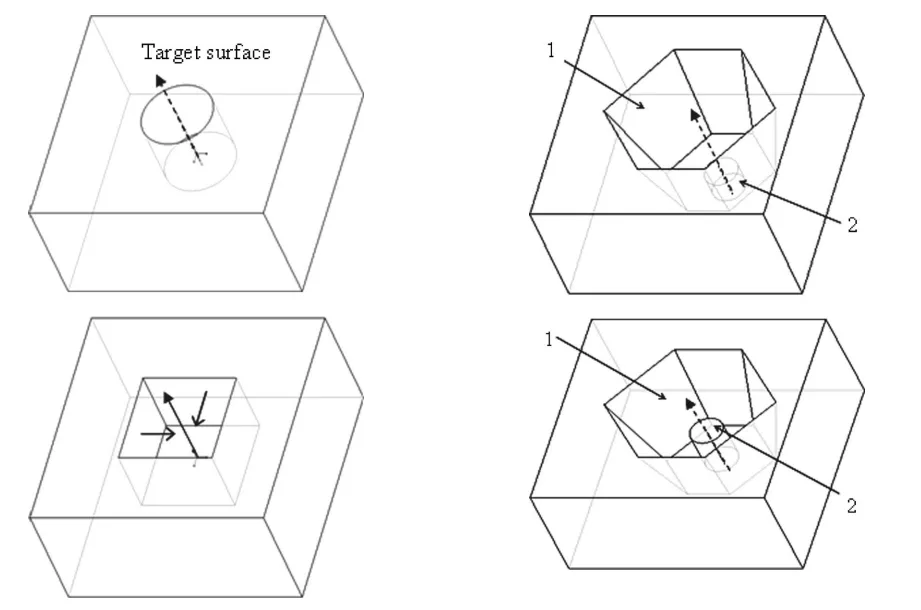
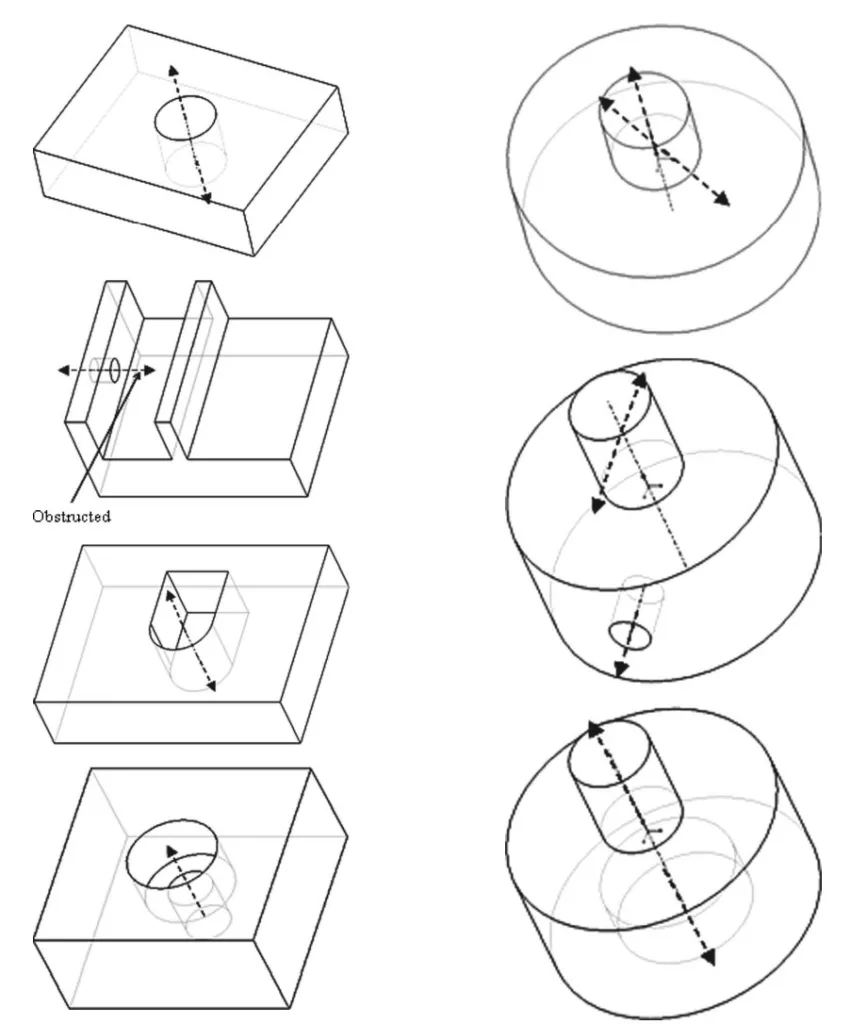
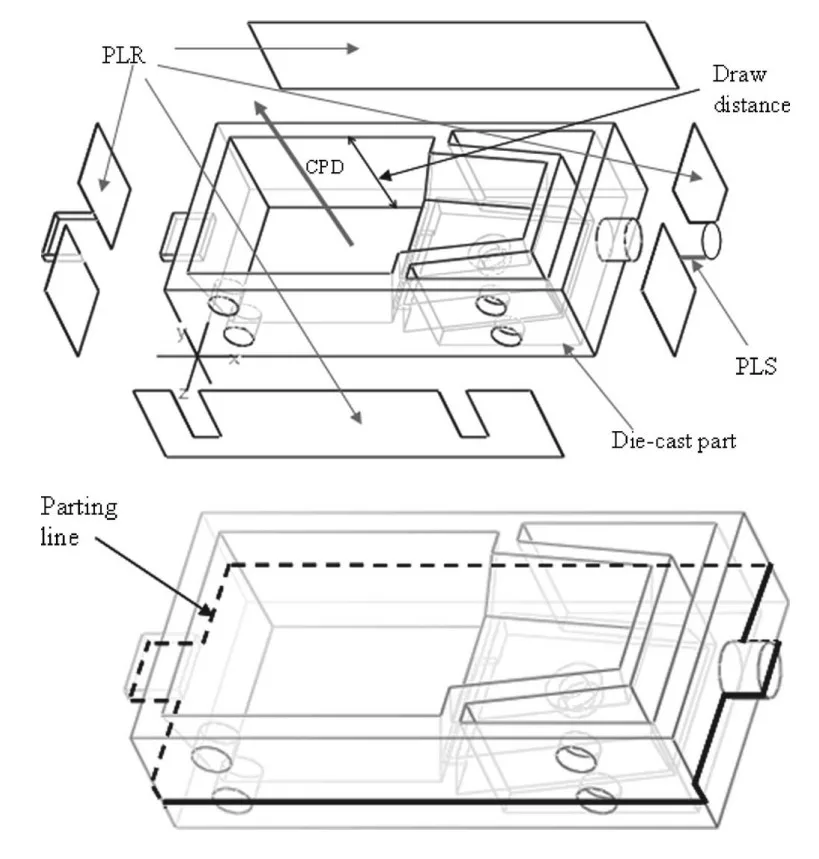
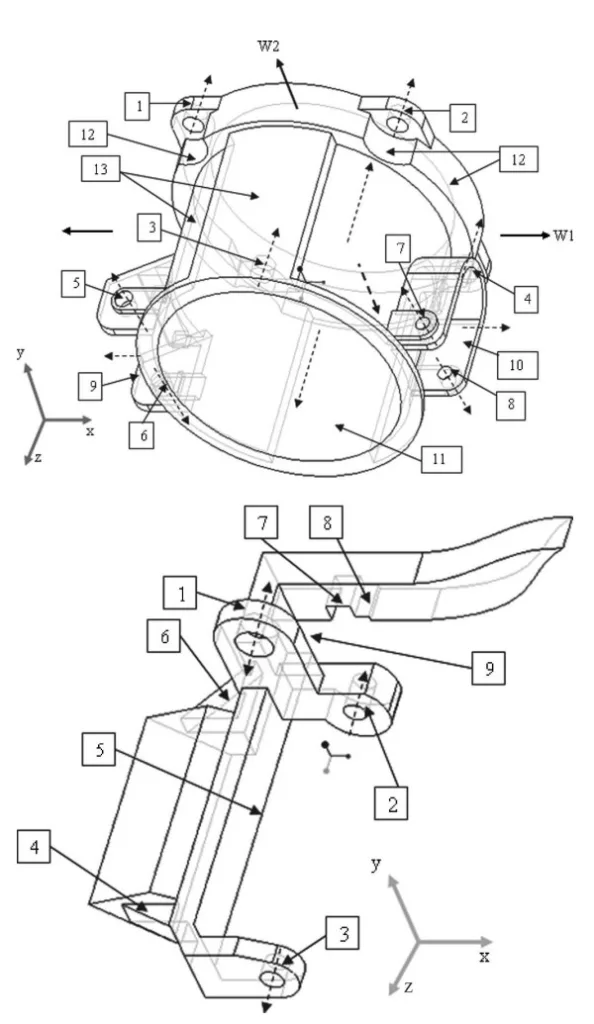
6. Conclusion and Discussion:
- Summary of Main Results: The research successfully developed and validated an automated system for die-casting feature recognition, parting direction, and parting line determination. This system effectively addresses the limitations of prior research by providing a more comprehensive and practical approach. It accurately identifies die-casting features, determines optimal parting directions and lines, and its results are consistent with expert judgments from the die-casting industry.
- Academic Significance of the Research: This research makes a significant academic contribution to the field of computer-aided design and manufacturing, specifically in the domain of die casting. The developed system advances the automation of critical design and process planning tasks. It introduces a novel methodology for feature recognition that is generic and does not rely on predefined libraries, enhancing its adaptability and scope. The use of global visibility and the incorporation of process constraints in parting direction and line determination represent a significant improvement over previous approaches.
- Practical Implications: The practical implications of this research are substantial for both part designers and process planners in the die-casting industry. The automated system offers several key benefits:
- Time Savings: Automates time-consuming manual processes, significantly reducing the time required for parting direction and parting line determination.
- Improved Efficiency: Enhances the efficiency of the design process and process planning activities.
- Cost Reduction: Contributes to reduced production time and part costs by optimizing mold design and process planning.
- Design-Manufacturing Integration: Facilitates better integration between design and manufacturing stages.
- Automated DFM Analysis: Enables automated Design for Manufacture analysis, allowing for early identification and resolution of manufacturability issues.
- Wider Applicability: Using STEP files as input ensures wider applicability across different CAD platforms.
- Limitations of the Research: The paper acknowledges certain limitations of the current research:
- Mold Type Assumption: The system assumes that parts are moldable using a two-piece mold, potentially with side cores. It does not explicitly address scenarios requiring split cores.
- Free-Form Surfaces: The current system does not directly handle parts with free-form surfaces. However, the authors suggest that integrating visibility and mold accessibility research on free-form surfaces could extend the system's applicability.
- Internal Split Cores: The system does not consider internal split cores, as their operation in die casting is deemed virtually impossible.
7. Future Follow-up Research:
- Directions for Follow-up Research: The authors propose several directions for future research to further enhance and expand the capabilities of the developed system:
- Handling Split Cores: Extending the system to accommodate die-casting scenarios that might require split cores (although acknowledged as less common and complex in die casting).
- Free-Form Surfaces Integration: Integrating techniques for handling free-form surfaces, potentially leveraging existing research on visibility and mold accessibility for such surfaces.
- Integration with Process Planning Systems: Developing interfaces and integration with broader computer-aided process planning (CAPP) systems to create a more comprehensive automated die-casting process planning environment.
- Integration with DFM Systems: Integrating the system with Design for Manufacture (DFM) systems to further automate manufacturability assessment of die-cast parts.
- Areas Requiring Further Exploration: Further exploration is recommended in the following areas:
- Complex Part Geometries: Testing and refining the system's performance on an even wider range of complex industrial part geometries.
- Process Constraints Refinement: Further investigation and incorporation of more detailed and nuanced die-casting process constraints into the system's decision-making processes.
- Evaluation Criteria Enhancement: Continuously refining the evaluation criteria used for parting direction and parting line selection to better reflect evolving industrial best practices and technological advancements in die casting.
8. References:
- [1] Gupta, S. K., Das, D., Regli, W. C., and Nau, D. S., 1997, "Automated Manufacturability Analysis: A Survey," Res. Eng. Des., 9(3), pp. 168-190.
- [2] Chen, L. L., Chou, S. Y., and Woo, T. C., 1993, "Parting Directions for Mould and Die Design," Comput.-Aided Des., 25, pp. 762-768.
- [3] Gan, G. H., Woo, T. C., and Tang, K., 1994, "Spherical Maps: Their Construction, Properties and Approximation," ASME J. Mech. Des., 116, pp. 357-363.
- [4] Elber, G., and Cohen, E., 1995, "Arbitrarily Precise Computation of Gauss Maps and Visibility Sets for Freeform Surface," Transactions of ACM Solid Modeling '95, Salt Lake City, UT.
- [5] Corney, J., Hayes, C., Sundararajan, V., and Wright, P., 2005, "The CAD/CAM Interface: A 25 Years Retrospective," ASME J. Comput. Inf. Sci. Eng., 5, pp. 188-191.
- [6] Gao, S., and Shah, J. J., 1998, "Automatic Recognition of Machining Features Based on Minimal Condition Subgraph," Comput.-Aided Des., 30(9), pp. 727-739.
- [7] Nnaji, B. O., Kang, T.-S., Yeh, S., and Chen, J.-P., 1991, "Feature Reasoning for Sheet Metal Components," Int. J. Prod. Res., 29(9), pp. 1867-1896.
- [8] Gavankar, P., and Henderson, M. R., 1990, "Graph Based Extraction of Protrusions and Depression From Boundary Representation," Comput.-Aided Des., 22(7), pp. 442-450.
- [9] Floriani, L. D., 1989, "Feature Extraction From Boundary Models of Three-Dimensional Objects," IEEE Trans. Pattern Anal. Mach. Intell., 2(8), pp. 785-798.
- [10] Lockett, H. L., and Guenov, M. D., 2005, "Graph-Based Feature Recognition for Injection Moulding Based on a Mid-Surface Approach," Comput.-Aided Des., 37, pp. 251-262.
- [11] McAdams, D. A., and Bidkar, R. A., 2003, "Automated Manufacturability Analysis for Injection Moulding and Die Cast Parts," Proceedings of DETC 2003/DFM-48154, Chicago, IL.
- [12] Fu, M. W., Fuh, J. Y. H., and Nee, A. Y. C., 1999, "Undercut Feature Recognition in an Injection Mold Design System," Comput.-Aided Des., 31, pp. 777-790.
- [13] Ye, X. G., Fuh, J. Y. H., and Lee, K. S., 2001, "A Hybrid Method for Recognition of Undercut Features From Molded Parts," Comput.-Aided Des., 33, pp. 1023-1034.
- [14] Ye, X. G., Fuh, J. Y. H., and Lee, K. S., 2004, "Automatic Undercut Feature Recognition for Side Core Design of Injection Molds," J. Mech. Des., 126, pp. 519-526.
- [15] Chung, K., Lee, K., and Kim, T., 2002, "Recognition of Pass Features for Automatic Parting Surface Generation in Injection Moulds," Proc. Inst. Mech. Eng., Part B, 216, pp. 783-796.
- [16] Lim, T., Corney, J., and Clark, D. E. R., 2001, "Laminae-Based Feature Recognition," IEEE Trans. Pattern Anal. Mach. Intell., 23(9), pp. 1043-1048.
- [17] Bralla, J. G., 1999, Design for Manufacturability Handbook, McGraw Hill, New York.
- [18] ASM, 1970, Metals Handbook, Forging and Casting, Vol. 5, American Society of Metals, Metals Park, OH.
- [19] Pye, R. G. W., 1978, Injection Mould Design: A Design Manual for the Thermoplastic Industry, The Plastic and Rubber Institute, London.
- [20] Ravi, B., and Srinivasan, M. N., 1990, "Decision Criteria for Computer Aided Parting Surface Design," Comput.-Aided Des., 22, pp. 11-18.
- [21] Madan, J., Rao, P. V. M., and Kundra, T. K., 2006, "Optimal Parting Direction Selection for Die-Casting," paper communicated to International Journal of Manufacturing Technology and Management.
- [22] Chen, Y., H., 1997, "Determining Parting Direction Based on Minimum Bounding Box and Fuzzy Logic," Int. J. Mach. Tools Manuf., 37(9), pp. 1189-1199.
- [23] Chen, Y. H., Wang, Y. Z., and Leung, T. M., 2000, "An Investigation of Parting Direction Based on Dexel Model and Fuzzy Decision Making," Int. J. Prod. Res., 38(6), pp. 1357-1375.
- [24] Chen, L. L., and Chou, S. Y., 1995, "Partial Visibility for Selecting a Parting Direction in Mould and Die Design," J. Manuf. Syst., 14(5), pp. 319-330.
- [25] Mochizuki, T., and Yuhara, N., 1992, "Methods of Extracting Potential Undercut and Determining Optimal Withdrawal Direction for Mold Designing," Int. J. Jpn. Soc. Precis. Eng., 26, pp. 68-73.
- [26] Yin, Z. P., Ding, H., and Xiong, Y. L., 2000, "Moldability Analysis for Near-Net-Shaped Manufactured Parts Using Freedom Cones," Int. J. Adv. Manuf. Technol., 16, pp. 169–175.
- [27] Yin, Z. P., Ding, H., and Xiong, Y. L., 2001, "Virtual Prototyping of Mold Design: Mouldablity Analysis for Near Net Shape Manufactured Parts by Feature Recognition and Geometric Reasoning," Comput.-Aided Des., 33, pp. 137-154.
- [28] Kurth, G. R., and Gadh, R., 1997, "Virtual Prototyping of Die-Design: Determination of Die-Open Directions for Near-Net-Shape Manufactured Parts With Extruded or Rotational Features," Comput.-Integr. Manuf. Syst., 10(1), pp. 69-81.
- [29] Fu, M. W., Fuh, J. Y. H., and Nee, A. Y. C., 1999, "Generation of Optimal Parting Direction Based on Undercut Features in Injection Molded Parts," IIE Trans., 31, pp. 947-955.
- [30] Khardekar, R., Burton, G., and McMains, S., 2006, "Finding Feasible Mold Parting Directions Using Graphics Hardware," Comput.-Aided Des., 38(4), pp. 327-341.
- [31] Lu, H. Y., and Lee, W. B., 2000, "Detection of Interference Elements and Release Directions in Die-Cast and Injection Molded Components," Proc. Inst. Mech. Eng., Part B, 214, pp. 431-441.
- [32] Huang, J., Gupta, S. K., and Stoppel, K., 2003, "Generating Sacrificial Multi-Piece Molds Using Accessibility Driven Spatial Partitioning," Comput.-Aided Des., 35(13), pp. 1147-1160.
- [33] Banerjee, A. G., and Gupta, S. K., 2006, "A Step Towards Automated Design of Side Actions in Injection Molding of Complex Parts," Geometric Modeling and Processing Conference, Pittsburgh, PA.
- [34] Tan, S. T., Yuen, M. F., Sze, W. S., and Kwong, K. W., 1990, "Parting Lines and Parting Surfaces of Injection Molded Parts," Proc. Inst. Mech. Eng., Part B, 204, pp. 211-219.
- [35] Wong, T., Tan, S. T., and Sze, W. S., 1998, "Parting Line Formation by Slicing a 3D CAD Model," Eng. Comput., 14, pp. 330-343.
- [36] Weinstein, M., and Manoochehri, S., 1997, "Optimum Parting Line Design of Molded and Cast Parts for Manufacturability," J. Manuf. Syst., 16, pp. 1-12.
- [37] Nee, A. Y. C., Fu, M. W., Fuh, J. Y. H., Lee, K. S., and Zhang, Y. F., 1998, "Automatic Determination of 3-D Parting Lines and Surfaces in Plastic Injection Mold Design," CIRP Ann., 47(1), pp. 95-98.
- [38] Fu, M. W., Nee, A. Y. C., and Fuh, J. Y. H., 2002, "The Application of Surface Visibility and Moldability to Parting Line Generation," Comput.-Aided Des., 34, pp. 469-480.
- [39] Nainy-Nejad, M., and Creese, R. C., 1999, "Computer Generation and Optimization of Parting Directions, Parting Lines and Core Cavities," One Hundred Third Annual Meeting of the American Foundrymen's Society, Rosemont, IL, September.
- [40] Penny, F. D., 1953, A Handbook of Die Casting, Ministry of Supply, York House, London.
- [41] Boothroyd, G., Dewhurst, P., and Knight, W., 1994, Product Design for Manufacture and Assembly, Marcel Dekker Inc, New York.
- [42] Elber, G., Chen, X., and Cohen, E., 2005, "Mold Accessibility via Gauss Map Analysis," ASME J. Comput. Inf. Sci. Eng., 5, pp. 79-85.
- [43] Pratt, M. J., and Wilson, P. R., 1985, "Requirements for Support of Form Features in a Solid Modelling System," Computer Aided Manufacturing International (CAMI), Paper No. R-85-ASPP-01.
- [44] Shah, J., and Rogers, M., 1988, "Functional Requirements and Conceptual Design of Feature Based Modeling System," Journal of Computer Aided Engineering, 5(1), pp. 9-15.
- [45] Shah, J. J., Anderson, D., Kim, Y. S., and Joshi, S., 2001 "A Discourse on Geometric Feature Recognition From CAD Models," ASME J. Comput. Inf. Sci. Eng., 1, pp. 41-51.
- [46] Dhaliwal, S., Gupta, S. K., and Huang, J., 2000, "Computing Exact Global Accessibility Cones for Polyhedral Objects," ASME Design for Manufacturability Conference, Baltimore, MD, September.
- [47] Dhaliwal, S., Gupta, S. K., Huang, J., and Priyadarshi, A., 2003, "Algorithm for Computing Global Accessibility Cones," ASME J. Comput. Inf. Sci. Eng., 3, 200-209.
- [48] Priyadarshi, A., and Gupta, S. K., 2004, "Geometric Algorithms for Automated Design of Multi-piece Permanent Molds," Comput.-Aided Des., 36(3), pp. 241-260.
- [49] Pahl, G., and Beitz, W., 1996, Engineering Design, Springer Verlag, London.
- [50] NADCA, 2007, Website of North American Die Casting Association, Rosemont, Illinois, http://www.diecasting.org/information/dc_shape. htm (accessed on Jan. 2, 2007).
- [51] Madan, J., Rao, P. V. M., and Kundra, T. K., 2006, "System for Early Cost Estimation of Die-Cast Parts," Int. J. Prod. Res., accepted for publication.
- [52] Zhao, Z., and Shah, J. J., 2005, "Domain Independent Shell for Dfm and Its Application to Sheet Metal Forming and Injection Molding," Comput.-Aided Des., 37, pp. 881-898.
9. Copyright:
- This material is Jatinder Madan, P.V.M. Rao, T.K. Kundra's paper: Based on Die-Casting Feature Recognition for Automated Parting Direction and Parting Line Determination.
- Paper Source: DOI: 10.1115/1.2768369
This material was summarized based on the above paper, and unauthorized use for commercial purposes is prohibited.
Copyright © 2025 CASTMAN. All rights reserved.